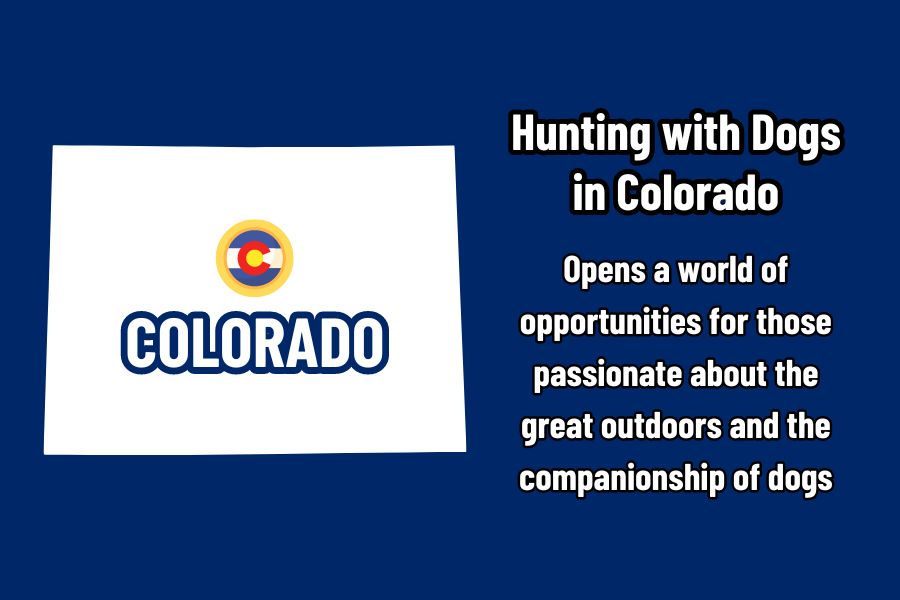Hunting with dogs in Colorado opens a world of opportunities for those passionate about the great outdoors and the companionship of dogs. Hunting with dogs in Colorado is not just a sport but a tradition that binds generations, enhancing the hunting landscape with camaraderie between hunter and canine.
The practice of hunting with dogs in Colorado stretches across various categories; whether you’re tracking a wounded mountain lion, flushing out small game, aiding in waterfowl retrieval, or pursuing furbearers, dogs play an integral role in the hunting experience.
Join us as we explore the regulations, preparations, and ethical considerations that come with this unique bond between hunter and dog in the majestic landscapes of Colorado.
Understanding Colorado’s Hunting Regulations
In diving into the heart of hunting regulations in Colorado, it’s pivotal to grasp the nuanced laws that govern the use of our four-legged friends in the chase. Here’s a breakdown to keep you on the right side of the law:
- General Regulations for Hunting with Dogs in Colorado:
- Can You Hunt Big Game in Colorado with Dogs? No, generally speaking dogs are not allowed to hunt or pursue big game. EXCEPTION: a tethered dog can assist in tracking and retrieving injured large-game animals, except black bears, provided an annual tracking license is obtained.
- Can You Hunt Small Game, Waterfowl and Furbearers in Colorado with Dogs?
Yes, dogs can be used to chase, corner, retrieve, flush, or point small game, waterfowl, and fur-bearing animals. Seasons EXCEPTION: dogs are not permitted to hunt cottontail rabbits, snowshoe hares, and tree squirrels in areas where deer, elk, pronghorn, or moose hunting seasons are active.
- On the Ground Rules:
- When you’re not on the hunt, keeping your dog on a leash no longer than 6 feet is the norm in most campgrounds and trails, safeguarding both wildlife and your furry companion.
- Wildlife reserve areas and preservation trails are no-dog zones, ensuring these sanctuaries remain undisturbed .
- Hunting Practices and Prohibitions:
- The allure of using artificial light, bait, or dogs to gain an upper hand while hunting bears, deer, elk, pronghorn, or moose is curbed by law, preserving the natural balance and challenge of the hunt .
- A vivid display of at least 500 square inches of solid daylight fluorescent orange or pink material above the waist is a safety measure you must follow during certain seasons .
- The principle of fair chase extends to the prohibition of careless hunting practices, including the discharge of firearms without due regard for life or property, and the use of loaded firearms or bows from or across public roads .
Navigating these regulations when hunting with dogs in Colorado ensures that traditions honor both the spirit of the sport and the conservation of our shared natural heritage. Remember, these rules not only protect the game and the ecosystems they inhabit but also reinforce the ethics and safety standards that define responsible hunting.
Big Game Species In Colorado
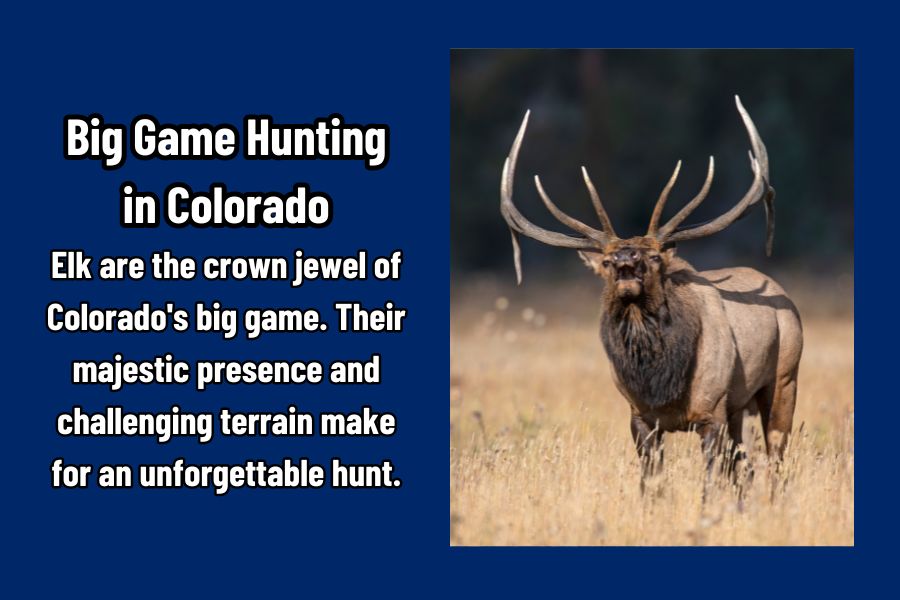
In the vast and varied landscapes of Colorado, hunters can pursue a range of big game species. Hunting with dogs in Colorado is generally not allowed except a leashed dog may assist a hunter track big game that is wounded. Here’s a closer look at the big game species:
- Elk:
- Population: Approximately 280,000 animals.
- Hunting Highlight: Known for world-class hunting experiences, elk are the crown jewel of Colorado’s big game. Their majestic presence and challenging terrain make for an unforgettable hunt.
- Moose:
- Growth: Rapid population increase since late 1970s transplants.
- Range Expansion: Now exploring wider territories, offering more hunting opportunities.
- Deer (Mule & White-tailed):
- Dispersion: Widely spread across the state, with Mule Deer being more prevalent.
- Hunting Experience: Offers a versatile hunting experience due to their widespread habitat. Deer dogs with a leash can be used for tracking wounded deer.
- Rocky Mountain Bighorn Sheep:
- Population: Nearly 7,000 animals thriving in the alpine tundra.
- Hunting Opportunities: Among the best for sheep hunting, challenging hunters with rugged terrains.
- Desert Bighorn Sheep:
- Habitat: Limited to western Colorado’s specific areas.
- Challenge: Offers a unique hunt due to their less common presence.
- Mountain Goat:
- Habitat: Inhabits steep, windswept ledges of Colorado’s highest peaks.
- Hunting Experience: A unique and physically demanding hunt, rewarding hunters with spectacular views and trophies.
- Pronghorn:
- Population: Nearly 90,000 animals primarily found in northwest Colorado and the Eastern Plains .
- Hunting Highlight: Known for their speed, hunting pronghorn is a test of strategy and marksmanship.
- Mountain Lion & Black Bear:
- Abundance: Populations are plentiful throughout Colorado, offering hunting opportunities for these elusive predators.
- Hunting Experience: Tracking these animals demands patience, skill, and a keen understanding of their behaviors.
Hunting big game in Colorado, the diversity of game ensures that whether you’re navigating the dense forests for elk or scaling rocky outcrops in pursuit of mountain goats, hunting with dogs in Colorado promises an adventure that deepens the bond between hunter and hound.
Small Game Species In Colorado

Exploring the realm of small game species in Colorado opens up a diverse and exciting hunting experience. Let’s dive into the variety of species that you and your favorite hound dogs can pursue:
- Squirrels:
- Albert’s Squirrel: Known for their distinctive tufted ears, these squirrels provide a unique hunting experience in the mountainous regions.
- Ground Squirrel: Common across Colorado, their presence signals the opportunity for both novice and experienced hunters.
- Marmot: Often found in higher elevations, hunting these large rodents requires patience and precision.
- Fox Squirrel & Pine Squirrel: Widespread and adaptable, these species offer a good starting point for those new to hunting with dogs in Colorado.
- Rabbits:
- Cotton Tail: Abundant and a popular choice, they offer a fast-paced hunting experience.
- Snowshoe Hare: Known for their winter white coat, these hares provide a challenging hunt in snowy conditions.
- Jackrabbit: Their speed and agility test the skills of both hunter and dog.
- White-tailed & Black-tailed: These species add variety to the hunting landscape, each presenting their own unique challenges.
- Prairie Dogs:
- White-tailed, Black-tailed, Gunnison’s: These social creatures are found in colonies, offering opportunities for strategic hunting approaches that can be both challenging and rewarding.
- Coyote: While not traditionally considered small game, coyotes are a common target for hunters in Colorado. Their cunning nature requires a strategic approach, making each hunt a thrilling experience.
This variety not only enriches the experience of hunting with dogs in Colorado but also contributes to the management and balance of these species’ populations. Hunting small game in Colorado with dogs not only strengthens the bond between hunter and dog but also fosters a deeper appreciation for the state’s natural diversity and the importance of conservation.
Furbearer Species In Colorado
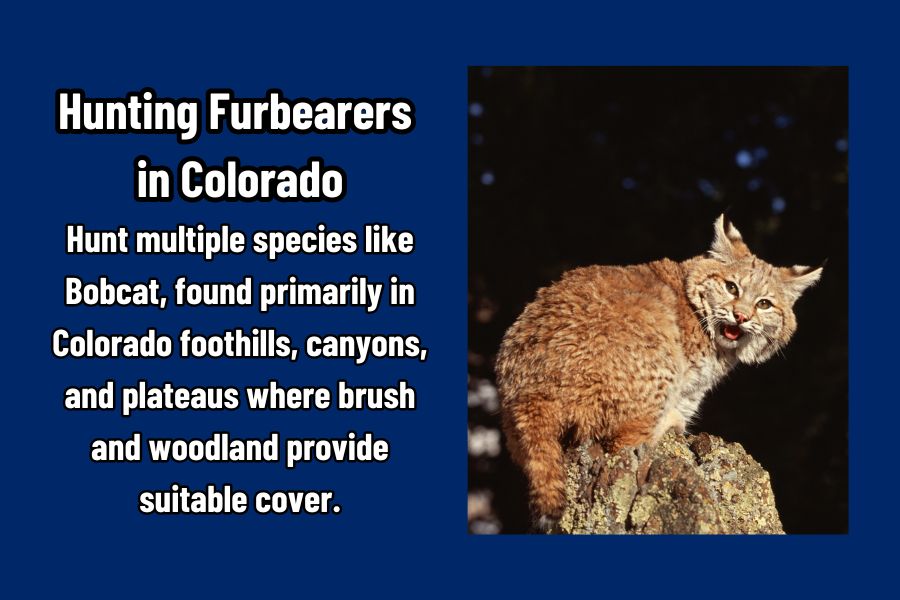
Furbearer species in Colorado are a fascinating array of animals that not only add to the biodiversity of our state but also present unique hunting opportunities for those of us keen on hunting with dogs in Colorado. Here’s a quick rundown of some of the furbearer species you might encounter:
- Badger: Known for their burrowing habits, badgers are a challenging target due to their elusive nature and tendency to dwell underground. Their presence is a sign of a healthy ecosystem.
- Mink: These semi-aquatic creatures are often found near water bodies. Hunting mink requires a keen understanding of their habitat and behaviors.
- Pine Marten: Residing in the dense forests of Colorado, pine martens are agile and primarily tree-dwelling, making them a rare sight for hunters.
- Foxes (Gray, Red, Swift): Each species of fox offers a different hunting experience. Gray foxes, with their ability to climb trees, red foxes, known for their cunning nature, and swift foxes, the smallest of the trio, present varied challenges for hunters and their dogs.
- Raccoon: Nighttime hunters will find raccoons a worthy target. Known for their intelligence and dexterity, raccoons can provide a stimulating hunt for coon dogs.
- Ring-Tailed Cat: Despite its name, this creature is more closely related to raccoons and provides an unusual hunting experience due to its nocturnal and elusive nature.
- Skunks (Striped & Western Spotted): While not typically hunted for sport, skunks are part of Colorado’s furbearer population. Caution and a good sense of wind direction are advised when near these defensively odorous animals.
- Weasels (Long-Tailed & Short-Tailed): These small, fast-moving predators require sharp eyes and quick reflexes from both hunter and dog.
- Opossum: The only marsupial found in North America, opossums are a rare sight in Colorado and offer a unique hunting experience.
- Muskrat: Commonly found in wetlands, muskrats are another semi-aquatic target for hunters, known for their valuable fur.
- Bobcat: Adult Bobcats stand about 30 to 60 cm (12 to 24 in) tall at the shoulders and are found primarily in Colorado foothills, canyons, and plateaus where brush and woodland provide suitable cover. Bobcats are common throughout these types of habitat in Colorado.
Each of these species contributes to the rich tapestry of wildlife in Colorado, offering hunters and their canine companions a chance to engage with nature in a meaningful and respectful way. Understanding the habits, habitats, and regulations surrounding furbearer hunting in Colorado is crucial for a successful and ethical hunting experience.
Game Bird Species In Colorado

Hunting game birds in Colorado with gun dogs offers a plethora of hunting opportunities that are as varied as they are thrilling. Each of these game bird species offers a unique hunting experience, let’s explore the possibilities.
- Pigeons & Doves
- Band-Tailed Pigeon: A larger cousin of the city pigeon, offering a challenging target due to their swift flight patterns.
- Dove Species (Mourning Dove, White-winged Dove, Eurasian Dove): These are among the most popular game birds due to their abundance and the skill required to hunt them. Mourning doves, in particular, are known for their acrobatic flight, making them a challenging target for hunters and their dogs.
- Grouse & Ptarmigan
- Dusky Blue Grouse & Greater Sage Grouse: These birds inhabit the sagebrush and alpine forests, requiring hunters to adapt to different terrains. Their elusive nature adds to the thrill of the hunt.
- Mountain Sharp-tailed Grouse: Known for their unique mating dances, hunting these birds offers a glimpse into the fascinating behaviors of Colorado’s wildlife .
- White-tailed Ptarmigan: Residing in the highest elevations, these birds are well-camouflaged against the snow, making them a prized find for hunters willing to brave the elements.
- Other Notables
- Chukar Partridge: Introduced to North America, chukars are known for their challenging uphill flights, testing the stamina of both hunter and dog.
- Pheasant: Perhaps the most iconic of all game birds, pheasants offer a colorful and exciting hunt, with their sudden bursts of flight and distinctive calls.
- Quail Species (Northern Bobwhite Quail, Scaled Quail, Gambel’s Quail): These birds offer a variety of hunting experiences, from the bobwhites’ whistling calls to the scaled quail’s preference for running over flying.
- Rail Species (Sora Rail, Virginia Rail): These marsh-dwelling birds require stealth and patience, offering a unique hunting experience in Colorado’s wetlands.
- Wilson’s Snipe: Often found in marshy areas, snipes are known for their zigzag flight patterns, presenting a challenging target for hunters.
Whether navigating dense forests for grouse or cautiously approaching the marshes for snipe, hunting with dogs in Colorado promises to be an exciting adventure. The bond between hunter, dog and wildlife fosters a deeper appreciation for the state’s natural diversity and the importance of conservation.
Waterfowl Species In Colorado
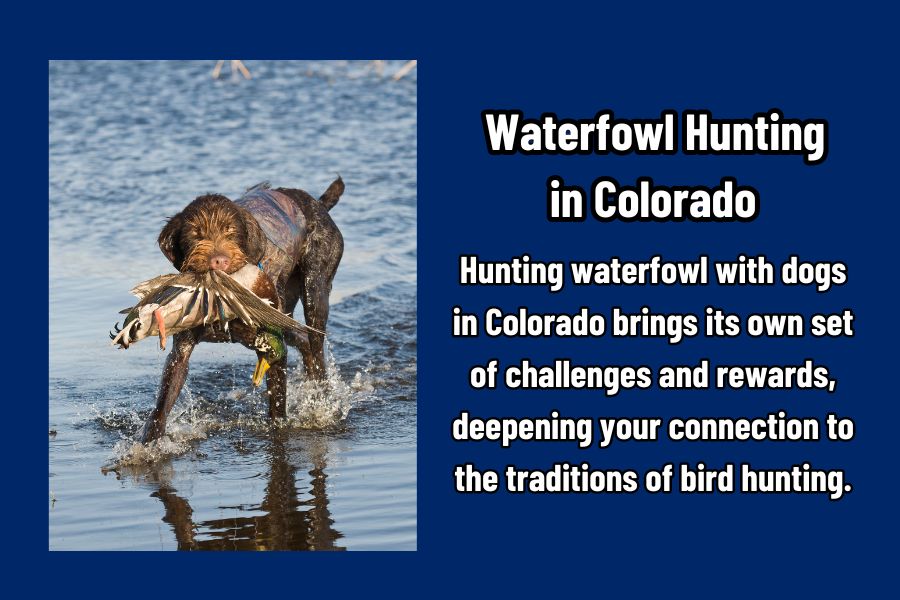
As we venture into the world of hunting waterfowl in Colorado, we’re greeted with a variety of species that not only challenge our hunting skills but also enrich our outdoor experiences. Let’s dive into the diversity of waterfowl species in Colorado.
- Ducks
- Gadwall: Appreciated for their subtle beauty, Gadwalls provide a unique challenge due to their cautious nature .
- Canvasback: Known for their distinctive shape and powerful flight, Canvasbacks are a prized catch for waterfowl hunters.
- Mallard: Perhaps the most recognized duck, Mallards are versatile and can be found in a variety of habitats across Colorado.
- Wood Duck: Admired for their striking appearance, Wood Ducks require stealthy approaches due to their wariness.
- Pintail: Elegant and fast, Pintails offer an exhilarating hunting experience with their swift flight patterns.
- Redhead & Hooded Merganser: Both species add to the diversity of the hunt, challenging hunters with their unique habits and habitats.
- Lesser Scaup & American Wigeon: These species are common targets, known for their sociable nature and tendency to flock in large numbers.
- Blue-winged Teal, Goldeneye, and Green-winged Teal: Small yet swift, these ducks test the precision and timing of hunters and their dogs.
- Goose
- Dark Goose (including Early Canada Goose): These larger waterfowl require careful strategy and patience, offering rewarding hunts for those who understand their patterns. Light Goose & Snow Goose: Known for their spectacular migrations, hunting these geese is a memorable experience, often involving large flocks and dynamic tactics .
- Coot
- Often overlooked, Coots provide an accessible hunting option and are known for their distinctive appearance and fleeting movements.
Whether you’re setting up decoys in a marsh for your duck hunting dogs to watch for incoming Mallards. Or tracking the migration patterns of Snow Geese, hunting with dogs in Colorado brings its own set of challenges and truly amazing rewards.
Hunter Education
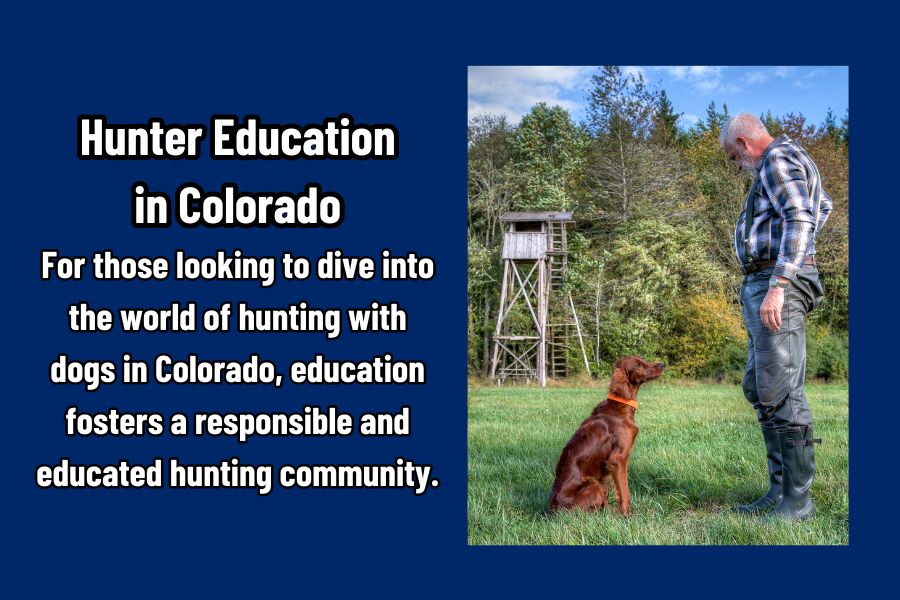
For both new and experienced hunters understanding the necessary steps to legally hunt in Colorado, foster a responsible and educated hunting community. Here are some key requirements you must follow:
Safe Hunting: The Role of Hunter Education
The safety of hunting in Colorado is largely attributed to the comprehensive hunter education programs. Colorado Parks and Wildlife (CPW) utilizes hunting as a method for wildlife management and its Hunter Education Program is crucial in achieving this. By training hunters to be cautious, ethical, and law-abiding, the program significantly contributes to the decline in hunting accidents. The success of [Safe Hunting] initiatives highlights the impact of thorough education and training.
Hunter Education Requirements in Colorado
In Colorado, individuals born on or after January 1, 1949, must successfully complete a recognized hunter education course to be eligible to purchase or apply for a hunting license. Colorado Parks and Wildlife offers these courses statewide, year-round, facilitated by certified hunter education instructors and CPW personnel.
Introduction to the Apprentice Hunter Certificate
The Apprentice Hunter Certificate allows a one-year exemption from the hunter education requirement and can be acquired twice, effective from March 1 to March 31. Eligible participants must be at least 10 years old, with those 10 and above able to hunt small game, and those 12 and above eligible for big game/small game hunting. The certificate necessitates that the holder is always accompanied by a mentor who is within both visual and vocal distance during hunting activities.
Verifying Your Hunter Education Credentials
Proof of completing a hunter education course can be demonstrated through various documents, including:
- A hunter education card (original, duplicate, or replacement) from any wildlife agency in the U.S., Mexico, or Canada.
- A Colorado Customer Identification (CID) card marked with a “V” for verification.
- A Missouri Conservation Heritage Card displaying a hunter education number.
- A Minnesota Driver’s License with an endorsed hunter education number.
- For international hunters, CPW assesses hunter education and licensing documents individually. Submit documentation well before your planned hunting season.
[Test Out Options] are available for those born on or after January 1, 1949, who lack a hunter education card and are either U.S. Military members or over 50 years old. Link [Test Out Options] to this URL
Conclusion
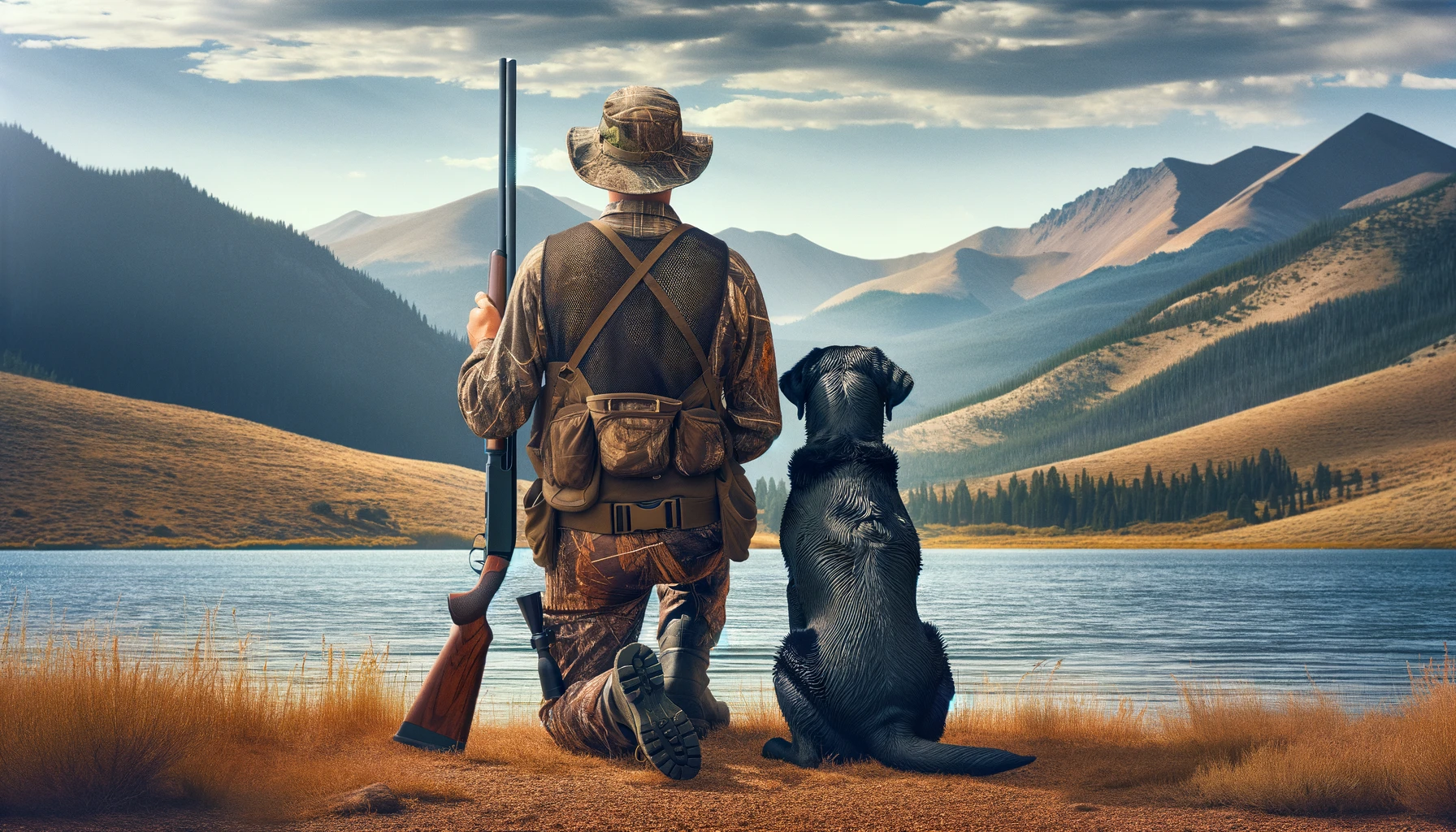
Navigating the rich beauty of Colorado through hunting is a journey that intertwines the tradition of the hunt with the conservation of nature’s wildlife. Hunting with dogs in Colorado for any specie is a unique adventure filled with exciting and unknown experiences.
The regulations and best practices shared in this post ensure that the adventures ahead are not only rewarding, respectful, ethical, but also preserve the Colorado wilderness we cherish for future generations.
As we conclude, remember that hunting with dogs in Colorado is more than a sport; it’s a way to connect deeply with nature, fostering a bond between hunter, dog, and habitat. Whether you’re a seasoned hunter or new to the world of hunting, the paths through Colorado’s wilderness await with challenges and triumphs, all shared with your loyal canine companion by your side.
FAQs – Hunting with Dogs in Colorado
How do I get a hunter education certification and card number in Colorado?
Hunting with Dogs in Colorado Answer:
To obtain a hunter education certification and card number in Colorado, you must complete a hunter education course. These courses are available both in person and online and cover topics such as wildlife management, firearms safety, hunting regulations, and outdoor ethics. After successfully completing the course, you will receive a certification card, which includes your hunter education number. This certification is required for anyone born on or after January 1, 1949, to purchase a Colorado hunting license.
How and where do I apply for the big game draw(s) to get one of the limited licenses in Colorado?
Hunting with Dogs in Colorado Answer:
To apply for the big game draw in Colorado, you must submit an application through the Colorado Parks and Wildlife (CPW) online system or at a CPW office. The application process typically opens in March each year, and deadlines vary for different species and hunting seasons. You will need to create an account on the CPW website, select the species you wish to hunt, and choose your preferred hunting units and seasons. Limited licenses are allocated through a draw system, and preference points can improve your chances of success.
What do I need to provide to buy a hunting license for small game in Colorado?
Hunting with Dogs in Colorado Answer:
To buy a hunting license for small game in Colorado, you must provide proof of hunter education certification if you were born on or after January 1, 1949. Residents and non-residents need a valid photo ID, social security number and if applicable, proof of residency. You can purchase the license through the Colorado Parks and Wildlife website, by phone, or in person at authorized sales agents or CPW offices.
Can I use dogs to hunt big game in Colorado?
Hunting with Dogs in Colorado Answer:
In Colorado, a dog can be used to aid in the search and recovery of wounded big-game animals, excluding black bears. To do this legally, you must obtain an annual tracking permit for your dog.
Can I use dogs to hunt small game, furbearers, and waterfowl in Colorado?
Hunting with Dogs in Colorado Answer:
In Colorado, dogs are permitted to assist in hunting small game, waterfowl, and furbearers by pursuing, cornering, retrieving, flushing, or pointing the game. However, during the active seasons for deer, elk, pronghorn, or moose, it is prohibited to use dogs for hunting cottontail rabbits, snowshoe hares, and tree squirrels on those lands.
Can I hunt waterfowl from a blind in Colorado?
Hunting with Dogs in Colorado Answer:
Hunting waterfowl in Colorado is allowed in the open, from a blind, or another concealed location, with the exception of sink boxes. If you camouflage a blind with natural vegetation from agricultural crops, it must not lead to the exposure, distribution, or scattering of grain or other feed.
Resources
SPECIAL NOTE: The regulations, license information, best practices, species, and other key information provided in this post are based on research using the Resources listed below. The information provided is subject to change without notice. Therefore all hunters should always verify current information published by Colorado Parks and Wildlife.
CPW: Colorado Parks & Wildlife (CPW)
CPW: Come Hunt With Us
CPW: Hunt Small Game
CPW: Hunting Waterfowl
CPW: 2023 Colorado Small Game & Waterfowl
CPW: Small Game Hunting Quick Guide
CPW: Turkey Hunting
CPW: Hunt Big Game
CPW: 2024 Colorado Big Game
CPW: 2024 Colorado Sheep & Goat
CPW: Hunter Education
CPW: Proof of Hunter Education
CPW: Bring The Dog Along
CPW: Important Reminders Before Hunting
CPW: Chapter 9 Division Properties
CPW: Plan Your Hunt
CPW: Apprentice Hunter Certificate
Hunter-Ed: Colorado Test-Out Exam
Colorado Wildlife Council: Benefits For All
Start planning your trip to go hunting with dogs in Colorado and check out our other posts about hunting with dogs in…
Alabama
Alaska
Arizona
Arkansas
California

